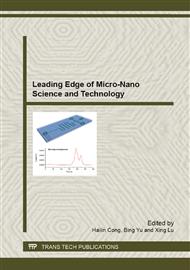p.302
p.307
p.311
p.316
p.325
p.331
p.335
p.340
p.349
Study on Micro-Nano Sensor System in Structure Vibration Safety Monitoring of Large Span Bridge
Abstract:
The conventional sensor in bridge structure vibration monitoring field has such disadvantages as high price and poor long-term stability. According to this insufficient, a kind of novel MEMS sensor micro system, which can be used to real-time monitor the structure vibration of large span bridge, is developed. For such system, the sensing element structure of 3D-MEMS is designed. The theoretical model of sensing test is established. And the three level packages, which are chip level, device level and micro-system level, is completed. The data acquisition system based on this sensor is developed. And this kind of sensor system has been applied to the structure health monitoring of the Yellow River bridge of Zhengzhou and the Yangtze River bridge of Wuhan to measure the horizontal, vertical vibration and acceleration signals. The measuring results show that this sensor micro-system has such advantages as good long-term stability, strong anti-interference ability, and high test sensitivity up to 2V/g. As it is simple, this test system can greatly reduce the testing cost.
Info:
Periodical:
Pages:
325-330
Citation:
Online since:
March 2013
Authors:
Price:
Сopyright:
© 2013 Trans Tech Publications Ltd. All Rights Reserved
Share:
Citation:


